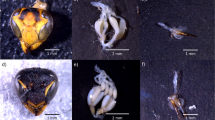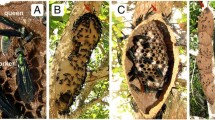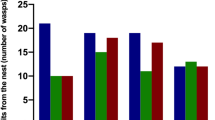Abstract
We investigated the influence of juvenile hormones (JH) on the composition of cuticular hydrocarbons (CHCs) and the division of labor in colonies of the African ant Myrmicaria eumenoides. CHCs have long been implicated in nestmate recognition in social insect colonies. In M. eumenoides, the CHC profiles also vary with the task performed from brood-tender-type to forager type. The endocrine factors regulating the task allocation as well as the intracolonial recognition cues are not well understood, but JHs are prime candidates. Only JH III was identified in the hemolymph of M. eumenoides workers. Foragers had significantly higher JH III titers than brood tenders. The application of exogenous JH III and a JH analogue (methoprene) to M. eumenoides workers did not result in an observable acceleration of task change in our study. However, longevity of the focus workers, and thus the observational period, was reduced by the applications. Changes from a brood-tender-type to a forager-type CHC profile were accelerated by the application of JH III and methoprene, resulting in brood-tending workers that displayed forager-type CHC profiles. We present the first data supporting that recognition cues of an eusocial Hymenopteran are influenced by JH III, which could thus play a major role in the regulation of the dynamic nature of social insect colonies. JH III is connected to at least two key processes: the acceleration of CHC changes and the more long-term modulation of task shifting. Moreover, this indicates that changes in CHC recognition cues do not trigger task allocation in social insect colonies.



Similar content being viewed by others
References
Arthur, C. L. and Pawliszyn, J. 1990. Solid-phase microextraction with thermal desorption using fused-silica optical fibers. Anal. Chem. 62:2145–2148.
Bloch, G., Borst, D. W., Huang, Z. Y., Robinson, G. E., and Hefetz, A. 2000. Juvenile hormone titers, juvenile hormone biosynthesis, ovarian development and social environment in Bombus terrestris. J. Insect Physiol. 46:47–57.
Bloch, G., Wheeler, D. E., and Robinson, G. E. 2002. Endocrine influences on the organisation of insect societies, pp. 195–236, in D. Pfaff (ed.). Hormones, Brain and Behavior, Vol. 3. Academic Press, San Diego, USA.
Blomquist, G. J., Tillmann, J. A., Mpuru, S., and Seybold, S. J. 1998. The cuticle and cuticular hydrocarbons of insects: Structure, function and biochemistry, pp. 34–54, in R. K. Vander Meer, M. Breed, M. Winston, and C. Espelie (eds.). Pheromone Communication in Social Insects. Westview Press, Boulder, CO, USA.
Bonavita-Cougourdan, A., Clement, J. L., and Lange, C. 1993. Functional subcaste discrimination (foragers and brood-tenders) in the ant Camponotus vagus Scop.: Polymorphism of cuticular hydrocarbon patterns. J. Chem. Ecol. 19:1461–1477.
Bortolotti, L., Duchateau, M. J., and Sbrenna, G. 2001. Effect of juvenile hormone on caste determination and colony processes in the bumblebee Bombus terrestris. Entomol. Exp. Appl. 101:143–158.
Bradshaw, J. W. S. and Howse, P. E. 1984. Sociochemicals of ants, pp. 429–473, in W. J. Bell and R. T. Carde (eds.). Chemical Ecology of Insects. Chapman and Hall, London, UK.
Brent, C. S., Schal, C., and Vargo, E. L. 2005. Endocrine changes in maturing primary queens of Zootermopsis angusticollis. J. Insect Physiol. 51:1200–1209.
Cameron, S. A. and Robinson, G. E. 1990. Juvenile hormone does not affect division of labor in bumble bee colonies (Hymenoptera: Apidae). Ann. Entomol. Soc. Am. 83:626–631.
Cuvillier-Hot, V., Cobb, W., Malosse, C., and Peeters, C. 2001. Sex, age and ovarian activity effect cuticular hydrocarbons in Diacamma ceylonense, a queenless ant. J. Insect Physiol. 47:485–493.
Dahbi, A. and Lenoir, A. 1998. Queen colony odor in the multiple nest ant species Cataglyphis iberica (Hymenoptera; Formicidae). Insectes Soc. 45:301–313.
Dietemann, V., Peeters, C., Liebig, J., Thivet, V., and Hölldobler, B. 2003. Cuticular hydrocarbons mediate discrimination of reproductives and nonreproductives in the ant Myrmecia gulosa. Proc. Natl. Acad. Sci. USA 100:10341–10346.
Fluri, P., Lüscher, M., Wille, H., and Gerig, L. 1982. Changes in weight of the pharyngeal gland and hemolymph titers of juvenile-hormone, protein and vitellogenin in worker honey bees. J. Insect Physiol. 28:61–68.
Francis, B. R., Blanton, W. E., Littlefield, J. L., and Nunamaker, R. A. 1989. Hydrocarbons of the cuticle and hemolymph of the adult honey bee (Hymenoptera: Apidae). Ann. Entomol. Soc. Am. 82:486–494.
Gäde, G., Hoffmann, K. H., and Spring, J. H. 1997. Hormonal regulation in insects: facts, gaps, and future directions. Physiol. Rev. 77:963–1032.
Giray, T. and Robinson, G. E. 1994. Effects of intracolony variability in behavioral-development on plasticity of division-of-labor in honey-bee colonies. Behav. Ecol. Sociobiol. 35:13–20.
Giray, T., Huang, Z. Y., Guzman-Novoa, E., and Robinson G. E. 1999. Physiological correlates of genetic variation for rate of behavioral development in the honeybee, Apis mellifera. Behav. Ecol. Sociobiol. 47:17–28.
Giray, T., Giovanetti, M., and West-Eberhard, M. J. 2005. Juvenile hormone, reproduction, and worker behavior in the neotropical social wasp Polistes canadensis. Proc. Natl. Acad. Sci. USA 102:3330–3335.
Gordon, D. M. and Mehdiabadi, N. J. 1999. Encounter rate and task allocation in harvester ants. Behav. Ecol. Sociobiol. 45:370–377.
Greene, M. J. and Gordon, D. M. 2003. Social insects—cuticular hydrocarbons inform task decisions. Nature 423:32–32.
Hadley, N. F. 1994. Water Relations of Terrestrial Arthropods. Academic Press, San Diego, USA.
Hadley, N. F. and Schultz, T. D. 1987. Water loss in three species of tiger beetles (Cicindela): Correlations with epicuticular hydrocarbons. J. Insect Physiol. 33:677–682.
Hartfelder, K. and Emlen, D. J. 2005. Endocrine Control of Insect Polyphenism, pp. 651–703, in L. I. Gilbert, K. Iatrou, and S. Gill (eds.) Comprehensive Insect Physiology, Biochemistry, Pharmacology, and Molecular Biology, Vol. 3. Elsevier, London, UK.
Hölldobler, B. and Wilson, E. O. 1990. The Ants. Harvard University Press, Cambridge, MA, USA.
Howard, R. W. and Blomquist, G. J. 2005. Ecological, behavioral, and biochemical aspects of insect hydrocarbons. Annu. Rev. Entomol. 50:371–393.
Huang, Z. Y. and Robinson, G. E. 1995. Seasonal changes in juvenile-hormone titers and rates of biosynthesis in honey-bees. J. Comp. Physiol. B 165:18–28.
Huang, Z. Y., Robinson, G. E., Tobe, S. S., Yagi, K. J., Strambi, C., Strambi, A., and Stay, B. 1991. Hormonal-regulation of behavioral-development in the honey-bee is based on changes in the rate of juvenile-hormone biosynthesis. J. Insect Physiol. 37:733–741.
Huang, Z. Y., Robinson, G. E., and Borst, D. W. 1994. Physiological correlates of division-of-labor among similarly aged honeybees. J. Comp. Physiol. A 174:731–739.
Huang, Z. Y., Kuang, H. O., and Qin, J. 2001. Juvenile hormone and division of labor in Apis cerana. Proc. 7th IBRA Conference on Tropical Bees and the 5th AAA Conference. Internal. Bec. Rec. Assoc. Cardiff, UK.
Johnston, A. B. and Wilson, E. O. 1985. Correlates of variation in the major minor ratio of the ant Pheidole dentata (Hymenoptera, Formicidae). Ann. Entomol. Soc. Am. 78:8–11.
Jutsum, A. R., Saunders, T. S., and Cherrett, J. M. 1979. Intraspecific aggression in the leaf-cutting ant Acromyrmex octospinosus. Anim. Behav. 27:839–844.
Kaib, M., Eisermann, B., Schoeters, E., Billen, J., Franke, S., and Francke, W. 2000. Task-related variation of postpharyngeal and cuticular hydrocarbon compositions in the ant Myrmicaria eumenoides. J. Comp. Physiol. A 186:939–948.
Kaib, M., Jmhasly, P., Wilfert, L., Durka, W., Franke, S., Francke, W., Leuthold, R. H., and Brandl, R. 2004. Cuticular hydrocarbons and aggression in the termite Macrotermes subhyalinus. J. Chem. Ecol. 30:365–385.
Kuhr, R. J. and Cleere, J. S. 1973. Toxic effects of synthetic juvenile hormones on several aphid species. J. Econ. Entomol. 66:1019–1022.
Lahav, S., Soroker, V., Hefetz, A., and Vander Meer, R. K. 1999. Direct behavioral evidence for hydrocarbons as ant recognition discriminators. Naturwissenschaften 86:246–249.
Liang, D. and Silverman, J. 2000. ‘You are what you eat’: Diet modifies cuticular hydrocarbons and nestmate recognition in the Argentine ant, Linepithema humile. Naturwissenschaften 87:412–416.
Liebig, J., Peeters, C., Oldham, N., Markstädter, C., and Hölldobler, B. 2000. Are variations in cuticular hydrocarbons of queens and workers a reliable signal of fertility in the ant Harpegnathos saltator? Proc. Natl. Acad. Sci. USA 97:4124–4131.
Lucas, C., Pho, D. B., Fresneau, D., and Jallon, J. M. 2004. Hydrocarbon circulation and colonial signature in Pachycondyla villosa. J. Insect Physiol. 50:595–607.
Lucas, C., Pho, D. B., Jallon, J. M., and Fresneau, D. 2005. Role of cuticular hydrocarbons in the chemical recognition between ant species in the Pachycondyla villosa species complex. J. Insect Physiol. 51:1148–1157.
Meola, R. W., Dean, S. R., and Bhaskaran, G. 2001. Effects of juvenile hormone on eggs and adults of the cat flea (Siphonaptera: Pulicidae). J. Med. Entomol. 38:85–92.
Monnin, T., Malosse, C., and Peeters C. 1998. Solid-phase microextraction and cuticular hydrocarbon differences related to reproductive activity in the queenless ant Dinoponera quadriceps. J. Chem. Ecol. 24:473–490.
Nei, M. 1972. Genetic distance between populations. Am. Nat. 106:283–291.
Nielsen, J., Boomma, J. J., Oldham, N. J., Peterson, H. C., and Morgan, E. D. 1999. Colony-level and season-specific variation in cuticular hydrocarbon profiles of individual workers in the ant Formica truncorum. Insectes Soc. 46:58–65.
Nowbahari, E., Lenoir, A., Clement, J. L., Lange, C., Bagneres, A. G., and Joulie, C. 1990. Individual, geographical and experimental variation of cuticular hydrocarbons of the ant Cataglyphis cursor (Hymenoptera: Formicidae): Their use in nest and subspecies recognition. Biochem. Syst. Ecol. 18:63–73.
O’Donnell, S. and Jeanne, R. S. 1998. Methoprene accelerates age polyethism in workers of a social wasp (Polybia occidentalis). Physiol. Entomol. 18:189–194.
Orth, A. P., Tauchman, S. J., Doll, S. C., and Goodman, W. G. 2003. Embryonic expression of juvenile hormone binding protein and its relationship to the toxic effects of juvenile hormone in Manduca sexta. Insect Biochem. Mol. Biol. 33:1275–1284.
Otto, D. 1962. Die Roten Waldameisen. Wittenberg Lutherstadt: Ziemsen, Germany.
Rembold, H., Czoppelt, C., Grüne, M., Lackner, B., and Pfeffer, J. 1992. Juvenile hormone titers during honey bee embryogenesis and metamorphosis, pp. 37–43, in B. Mauchamp, F. Couillard, and J. C. Baehr (eds.). Insect Juvenile Hormone Research. INRA, Paris.
Robinson, G. E. 1985. Effects of a juvenile-hormone analog on honey bee foraging behaviour and alarm pheromone production. J. Insect Physiol. 31:277–282.
Robinson, G. E. and Vargo, E. L. 1997. Juvenile hormone in adult eusocial Hymenoptera: Gonadotropin and behavioral pacemaker. Arch. Insect Biochem. 35:559–583.
Robinson, G. E., Page, R. E., Strambi, A., and Strambi, C. 1989. Hormonal and genetic control of behavioral integration in honeybee colonies. Science 246:109–111.
Sasagawa, H., Sasaki, M., and Okada, I. 1989. Hormonal control of the division of labor in adult honeybees (Apis mellifera L.). 1. Effect of methoprene on corpora allata and hypopharyngeal gland, and its alpha-glucosidase activity. Appl. Entomol. Zool. 24:66–77.
Schal, C., Gu, X., Burns, E. L., and Blomquist, G. J. 1994. Patterns of biosynthesis and accumulation of hydrocarbons and contact sex pheromone in the female German cockroach Blattella germanica. Arch. Insect Biochem. Physiol. 25:375–391.
Schal, C., Sevala, V., Young, H. P., and Bachmann, J. A. S. 1998. Sites of synthesis and transport pathways of insect hydrocarbons: Cuticle and ovary as target tissues. Am. Zool. 38:382–393.
Schal, C., Fan, Y., and Blomquist, G. J. 2003. Regulation of pheromone biosynthesis, transport and emission in cockroaches, pp. 283–322, in G. J. Blomquist and R. Vogt (eds.). Insect Pheromone Biochemistry and Molecular Biology: The Biosynthesis and Detection of Pheromones and Plant Volatiles. Elsevier, Amsterdam, The Netherlands.
Schulz, D. J., Sullivan, J. P., and Robinson, G. E. 2002. Juvenile hormone and octopamine in the regulation of division of labor in honeybee colonies. Horm. Behav. 42:222–231.
Searle, S., Casella, G., and Mcculloch, C. 1992. Variance Components. Wiley, New York, USA.
Sevala, V. L., Bachmann, J. A. S., and Schal, C. 1997. Lipophorin: a haemolymph juvenile hormone binding protein in the German cockroach Blattella germanica. Insect Biochem. Mol. Biol. 27:663–670.
Sommer, K., Hölldobler, B., and Rembold, H. 1993. Behavioral and physiological aspects of reproductive control in a Diacamma species from Malaysia (Formicidae, Ponerinae). Ethology 94:162–170.
Stevens, S. and Hofmeyr, J. H. S. 1993. Effects of ethanol, octanoic and decanoic acids on fermentation and the passive influx of protons through the plasma membrane of Saccharomyces cerevisiae. Appl. Microbiol. Biotechnol. 38:656–663.
Sullivan, J. P., Jassim, O., Fahrbach, S. E., and Robinson, G. E. 2000. Juvenile hormone paces behavioral development in the adult worker honey bee. Horm. Behav. 37:1–14.
Thomas, M. L., Parry, L. P., Allan, R. A., and Elgar, M. E. 1999. Geographic affinity, cuticular hydrocarbons and colony recognition in the Australian meat ant Iridomyrmex purpureus. Naturwissenschaften 86:87–92.
Tillman, J. A., Holbrook, G. L., Dallara, P. L., Schal, C., Wood, D. L., Blomquist, G. J., and Seybold, S. J. 1998. Endocrine regulation of de novo aggregation pheromone biosynthesis in the pine engraver Ips pini (Say) (Coleoptera: Scolytidae). Insect Biochem. Mol. Biol. 28:705–715.
Tillman, J. A., Seybold, S. J., Jurenka, R. A., and Blomquist, G. J. 1999. Insect pheromones—an overview of biosynthesis and endocrine regulation. Insect Biochem. Mol. Biol. 29:481–514.
Tittiger, C., Barkawi, L. S., Bengoa, C. S., Blomquist, G. J., and Seybold, S. J. 2003. Structure and juvenile hormone-mediated regulation of the HMG-CoA reductase gene from the Jeffrey pine beetle, Dendroctonus jeffrey. Mol. Cell. Endocrinol. 199:11–21.
Wagner, D., Brown, M. J. F., Broun, P., Cuevas, W., Moses, L. E., Chao, D. L., and Gordon, D. M. 1998. Task-related differences in the cuticular hydrocarbon composition of harvester ants, Pogonomyrmex barbatus. J. Chem. Ecol. 24:2021–2037.
Wagner, D., Tissot, M., Cuevas, W., and Gordon, D. 2000. Harvester ants utilize cuticular hydrocarbons in nestmate recognition. J. Chem. Ecol. 26:2245–2257.
Wagner, D., Tissot, M., and Gordon, D. 2001. Task-related environment alters the cuticular hydrocarbon composition of harvester ants. J. Chem. Ecol. 27:1805–1819.
Westerlund, S. A. and Hoffmann, K. H. 2004. Rapid quantification of juvenile hormones and their metabolites in insect hemolymph by liquid chromatography-mass spectrometry (LC-MS). Anal. Bioanal. Chem. 379:540–543.
Wilson, E. O. 1971. The Insect Societies. Harvard University Press, Cambridge, MA, USA.
Wilson, E. O. 1983. Caste and division of labor in leaf-cutter ants (Hymenoptera: Formicidae: Atta). IV. Colony ontogeny of A. cephalotes. Behav. Ecol. Sociobiol. 14:55–60.
Acknowledgment
We thank Antje Halwas for help and support during the investigations, and we are grateful to Konrad Fiedler for advice regarding statistical problems. This study was supported by the Deutsche Forschungsgemeinschaft as part of the Graduiertenkolleg 678 at the University of Bayreuth.
Author information
Authors and Affiliations
Corresponding author
Rights and permissions
About this article
Cite this article
Lengyel, F., Westerlund, S.A. & Kaib, M. Juvenile Hormone III Influences Task-Specific Cuticular Hydrocarbon Profile Changes in the Ant Myrmicaria eumenoides . J Chem Ecol 33, 167–181 (2007). https://doi.org/10.1007/s10886-006-9185-x
Published:
Issue Date:
DOI: https://doi.org/10.1007/s10886-006-9185-x




